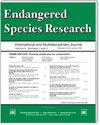滑翔机探测到的北大西洋露脊鲸、蓝鲸和长须鲸叫声在交通繁忙航道附近的变化情况
IF 2.9
2区 环境科学与生态学
Q2 BIODIVERSITY CONSERVATION
引用次数: 0
摘要
摘要:被动声学监测已成为确定声乐活跃的鲸类物种的存在、分布和行为不可或缺的工具。配备声学设备的水下滑翔机正在成为一种常规监测平台,因为它们可以在一次部署中覆盖较大的空间范围,并有能力将数据近乎实时地传送到岸上。然而,要确定能从滑翔机记录的鲸目动物探测结果中获得哪些信息,还需要进行更多的研究。在此,2019 年 9 月和 10 月期间,我们在加拿大圣劳伦斯湾的洪盖多海峡和相关的交通隔离计划上部署了一台斯洛克姆滑翔机,该滑翔机可持续监测低频(1 kHz)须鲸的发声。我们对存档音频进行了人工分析,以研究北大西洋露脊鲸(NARWs)、蓝鲸和长须鲸声学探测率的时空变化。对蓝鲸和长须鲸的呼叫探测表明,这两个物种在整个部署过程中都很活跃。环境关联模型表明,它们优先使用劳伦海峡南坡的觅食区。结果还表明,航道上船舶交通造成的背景噪声水平升高对探测到蓝鲸声学存在的可能性影响很小,而对长须鲸的可探测性没有影响。在不到 20% 的部署天数中,都能明确探测到 NARWs,因此只能对其存在情况进行定性评估。尽管如此,对所有 3 个物种的探测都突出表明,它们在这一重要季节性区域的活动与大量的船只交通重叠,增加了它们遭受船只撞击的风险。本文章由计算机程序翻译,如有差异,请以英文原文为准。
Variation in glider-detected North Atlantic right, blue, and fin whale calls in proximity to high-traffic shipping lanes
ABSTRACT: Passive acoustic monitoring has become an integral tool for determining the presence, distribution, and behavior of vocally active cetacean species. Acoustically equipped underwater gliders are becoming a routine monitoring platform, because they can cover large spatial scales during a single deployment and have the capability to relay data to shore in near real-time. Yet, more research is needed to determine what information can be derived from glider-recorded cetacean detections. Here, a Slocum glider that monitored continuously for low frequency (<1 kHz) baleen whale vocalizations was deployed across the Honguedo Strait and the associated traffic separation scheme in the Gulf of St. Lawrence, Canada, during September and October 2019. We conducted a manual analysis of the archived audio to examine spatial and temporal variation in acoustic detection rates of North Atlantic right whales (NARWs), blue whales, and fin whales. Call detections of blue and fin whales demonstrated that both species were acoustically active throughout the deployment. Environmental association models suggested their preferential use of foraging areas along the southern slopes of the Laurentian Channel. Results also indicate that elevated background noise levels in the shipping lanes from vessel traffic only minimally influenced the likelihood of detecting blue whale acoustic presence, while they did not affect fin whale detectability. NARWs were definitively detected on less than 20% of deployment days, so only qualitative assessments of their presence were described. Nevertheless, detections of all 3 species highlight that their movements throughout this seasonally important region overlap with a high volume of vessel traffic, increasing their risk of ship strike.
求助全文
通过发布文献求助,成功后即可免费获取论文全文。
去求助
来源期刊

Endangered Species Research
BIODIVERSITY CONSERVATION-
CiteScore
5.50
自引率
6.50%
发文量
38
审稿时长
31 weeks
期刊介绍:
ESR is international and interdisciplinary. It covers all endangered forms of life on Earth, the threats faced by species and their habitats and the necessary steps that must be undertaken to ensure their conservation. ESR publishes high quality contributions reporting research on all species (and habitats) of conservation concern, whether they be classified as Near Threatened or Threatened (Endangered or Vulnerable) by the International Union for the Conservation of Nature and Natural Resources (IUCN) or highlighted as part of national or regional conservation strategies. Submissions on all aspects of conservation science are welcome.
 求助内容:
求助内容: 应助结果提醒方式:
应助结果提醒方式:


